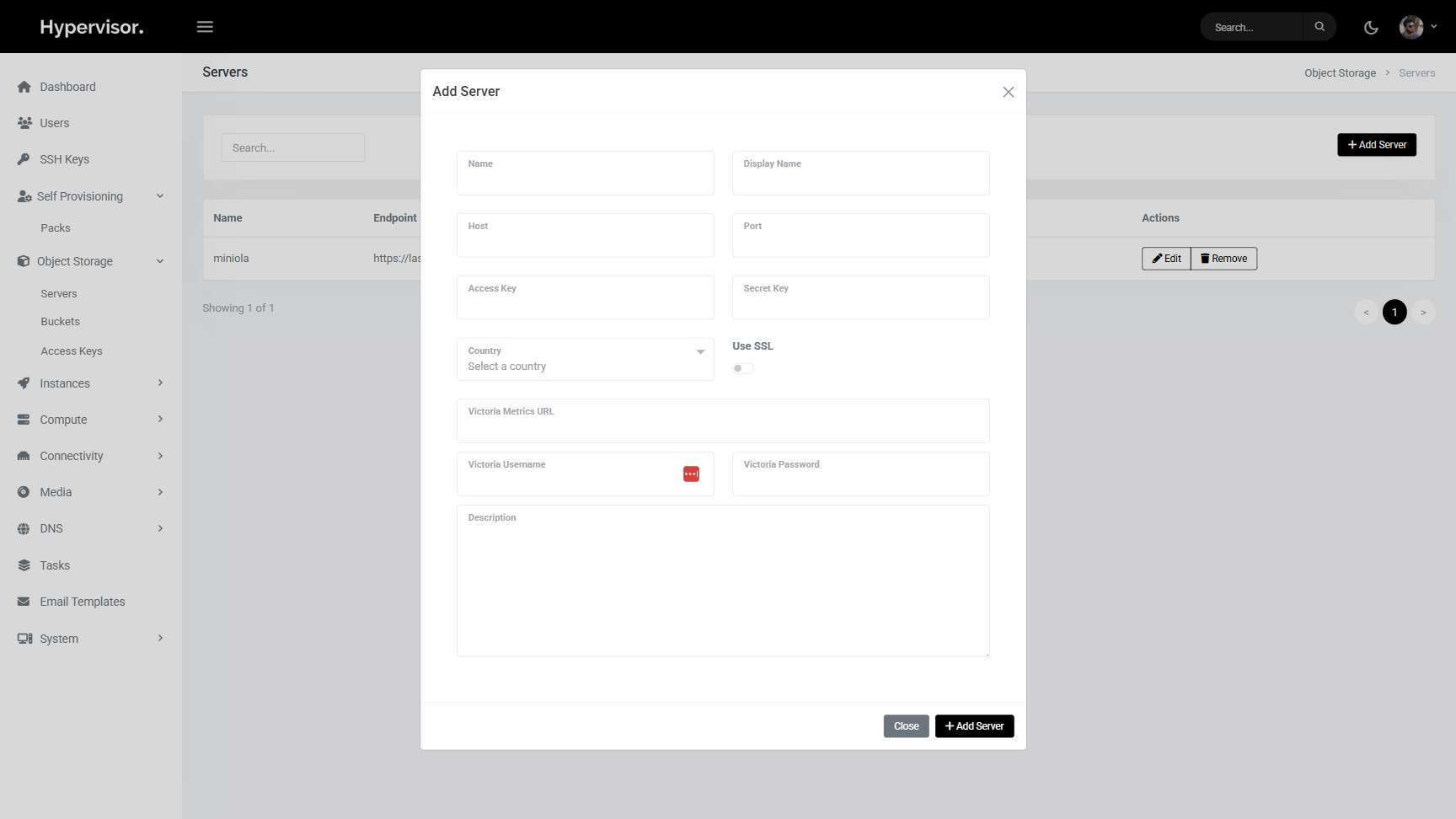Object Storage Setup
Pre-requisite
This guide assumes you have your own MinIO Cluster setup on a remote location.
Setup VictoraMetrics - Bandwidth Accounting
We will setup VictoriaMetrics a time-series database which will store those metrics in the TSDB for us to use for querying purposes.
You can look for a file named victoria-metrics-linux-amd64-vXXX.tar.gz and vmutils-linux-amd64-vXXX.tar.gz
And download the same on your linux server, for our use case at the time of writing this guide, we will go with the assumption that it's v1.126.0
wget https://github.com/VictoriaMetrics/VictoriaMetrics/releases/download/v1.126.0/victoria-metrics-linux-amd64-v1.126.0.tar.gz -O /tmp/vm.tar.gz
tar -zxvf /tmp/vm.tar.gz
cp victoria-metrics-prod /usr/local/bin/victoria-metrics-prod
chmod +x /usr/local/bin/victoria-metrics-prod
Now we will prepare a systemd file for running the executable using the following content
#/etc/systemd/system/victoriametrics.service
[Unit]
Description=High-Permance, scalable time series database for prometheus
After=network.target
[Service]
Type=simple
Restart=on-failure
RestartSec=5
ExecStart=/usr/local/bin/victoria-metrics-prod -storageDataPath=/mnt/victoria_metrics -httpListenAddr=127.0.0.1:8429 -retentionPeriod=3 -search.disableAutoCacheReset
ExecStop=/bin/kill -s SIGTERM
LimitNOFILE=65536
LimitNPROC=32000
[Install]
WantedBy=multi-user.target
-retentionPeriod flag is important, this will decide how many months of historical data do you want to maintain.
TSDB Authentication Layer
Now we will download the VM Utilities, package, which will have 2 files that we will need.
vmauth-prod & vmagent-prod
wget https://github.com/VictoriaMetrics/VictoriaMetrics/releases/download/v1.126.0/vmutils-linux-amd64-v1.126.0.tar.gz -O /tmp/vmutils.tar.gz
tar -zxvf /tmp/vmutils.tar.gz
cp vmauth-prod /usr/local/bin/
cp vmagent-prod /usr/local/bin/
We will now create another systemd unit file for running this service
#/etc/systemd/system/vmauth.service
[Unit]
Description=Proxy for victoria-metrics
After=network.target
[Service]
Restart=on-failure
RestartSec=5
ExecStart=/usr/local/bin/vmauth-prod -auth.config=/etc/vmauth.yaml -httpListenAddr=0.0.0.0:8428
ExecStop=/bin/kill -s SIGTERM $MAINPID
[Install]
WantedBy=multi-user.target
We will then create the following authentication config for the above service.
#/etc/vmauth.yaml
users:
- username: 'grafana-write'
password: 'somerandompassword'
url_prefix: 'http://127.0.0.1:8429'
Setup MinIO metrics endpoint
The following command would give you a json output with the bearer token, that's all we need for now.
mc admin prometheus generate <ALIAS> bucket --json
Setting up Scraping
You can setup vmagent-prod on the same server as minio-cluster or some server that has access to the said minio-cluster directly
#/etc/systemd/system/vmagent.service
[Unit]
Description=Proxy for prometheus style scraping
After=network.target
[Service]
Restart=always
RuntimeMaxSec=1d
RestartSec=5
ExecStart=/usr/local/bin/vmagent-prod -promscrape.configCheckInterval=10s \
-httpListenAddr=127.0.0.1:8430 \
-promscrape.config=/etc/scrape.yaml \
-remoteWrite.url=http://<vmauth or victoriametrics ip>:8428/api/v1/write \
-httpAuth.username "grafana-write" \
-httpAuth.password "somerandompassword"
ExecStop=/bin/kill -s SIGTERM $MAINPID
[Install]
WantedBy=multi-user.target
#/etc/scrape.yaml
scrape_configs:
- job_name: minio-job
bearer_token: eyJhbGciOiJIUzUxMiIsInR5cCI6IkpXVCJ9.eyJpc3MiOiJwcm9tZXRoZXVzIiwic3ViIjoiYWRtaf4iLGJleHAiOjQ5MTA4NTg3ODl9.gagR4U2KfvRj6zPUYqVIDXkh9ND6dsJem7XhcqY_WJgdmpzTuS7RL8Xj62mEvuPlDnU0cdk2u-_TihoMZWbi1Q
metrics_path: /minio/v2/metrics/cluster
scheme: http
static_configs:
- targets: ['<your-minio-cluster>:<port>']
relabel_configs:
- source_labels: [__address__]
target_label: __param_target
- source_labels: [__param_target]
target_label: instance
Install MC client on your Management Server
curl https://dl.min.io/client/mc/release/linux-amd64/mc -o /usr/local/bin/mc
chmod +x /usr/local/bin/mc
mc --help
Adding the Minio Server in your Management Server

- Host Your Host Address for MinIO Cluster
- Port It can be 80 or 443 if you have a reverse-proxy setup like nGINX or directly your MinIO API port which is 9000 by default
- Use SSL If SSL certificate is present, then use this.
- Access Key The admin username or a username with Administrator rights.
- Secret Key The password for the above user
- VictoriaMetrics URL This would be your victoriametrics url in our case http://<your-victoriametrics-ip>:8428/
- VictoriaMetrics Username The username your put in
vmauth-prod - VictoriaMetrics Password The password your put in
vmauth-prod
Rest is all self-explanatory and you are good to go.